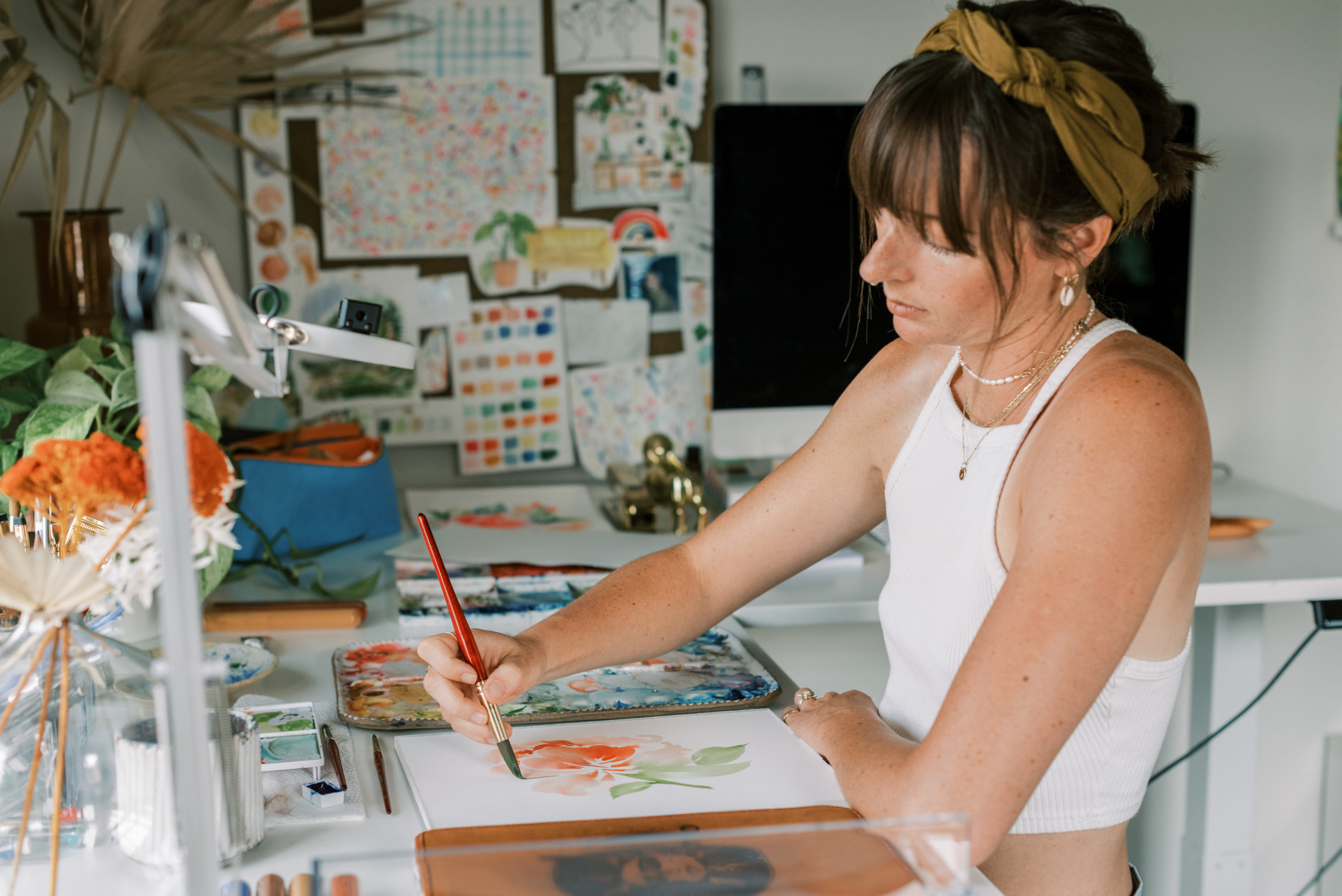Knowing how to clean watercolor brushes is really not that complex. Thankfully, watercolor brushes are relatively easy to care for and when cleaned properly, they can last you a very long time! The most traditionally coveted watercolor brush is a Sable hair brush. These brushes are natural hair and can last you a lifetime if you care for them in the steps I include below. However, I use synthetic sable hair brushes. The technology in brush making these days is *chef’s kiss* fantastic and synthetic sable goes at a fraction of the price!
If you want a list of my favorite brushes, click here and definitely check out my new collab with Princeton Brush for the amazing “Blooms” brush!
Before we get into how to clean watercolor brushes, let’s talk about the parts and the anatomy of watercolor brushes first!
The Anatomy of a Watercolor Brush

Handle: This is where you grip the brush! The handle will include the brush name and series number and is typically made of wood or plastic.
Ferrule: This is the metal part of the brush that’s connected to the handle and the hairs of the brush. Where the ferrule and handle meet is also called the crimp.
Head: The hair of the brush is also referred to as the head, which includes the tip and the belly of the brush.
Watercolor brushes are typically made with finer hairs and are quite delicate, so cleaning these brushes is quite crucial to extend the brush’s life! It’s really easy for pigment and dust to accumulate in these hairs, making them stiffen up and dry out. If you want them to retain their flexibility and water retention skills, it’s important to regularly clean them.
How Often Should You Clean Your Brushes?
A deep cleaning? Every few months. I’ll talk about that in a bit. But after every single painting session, you should at least be rinsing your brushes off. If not, the hairs of your brushes will harden and lose their shape!
So, let’s talk about ways to clean your brushes…
Commercial Brush Cleaners
I personally don’t use any commercial brush cleaners. Most of these will include synthetic and incredibly harsh ingredients that can strip the hairs of the brush and also aren’t ideal for touching with your skin. So I skip out on these and use another method.
How I Clean Watercolor Brushes
Water and Branch Basics soap! Yep. It’s that easy!
This soap is plant and mineral based, free of synthetics and harmful chemicals and smells awesome.
I just rinse my brushes under clean water first, then put a dab of the Branch Basics concentrate onto a clean surface (usually a plate) and roll the hairs of the brushes around in the concentrate. Then I rub it in a little bit with my fingers and rinse really well under water to get rid of the soap and leftover pigment! Boom, done!
Best Tips for Caring for Watercolor Brushes
Once you’ve cleaned or rinsed your brushes, it’s important to take these extra steps in caring for them to make sure they keep their hold and form:
- Never leave your brushes tip down in a water cup. This is a huge NO NO! This will smash and damage the shape and hair of your brush!
- I like to take my pointer finger and thumb and re-shape the brush when it’s damp. This will help put back any scraggler hairs and help it keep its form.
- Lay your brushes flat! You don’t want water running down your brush and into the ferrule, this will loosen the crimp over time!
- Rinse your brushes while you’re painting. This may be a no-brainer, but rinsing your brushes while you work is a good tip.
- Don’t store a damp or wet brush in any type of container, bag, etc. This will make for some icky mold!
Art supplies and especially brushes can get expensive, so taking these few, simple steps to clean and care for them is essential in getting the most out of your investment! I also have a video on how I clean my brushes HERE if you want to check it out.
Want my (totally free) 40-page “Complete Beginner’s Guide to Watercolor” eBook? Check it out here!









Good information and can’t hear it too much! Thank you Jenna for all the expert information, videos, and blogs you put out there for us!!!!!
Glad it was helpful!!
Thanks for all the good information! I really enjoy your website and I’m just getting into watercolor painting, we’ll see how it goes.
Specific question: do you have any information about a type of soap that would be good for brushes but much cheaper? You might say I am on the much poorer end of the spectrum but I would hate to rely on harsh soaps simply because it is cheaper. Or do you have specifications for good brush soap that I can look for? Does it work best if concentrated? Or can I use a natural soap that isn’t concentrated?
Thanks for you help